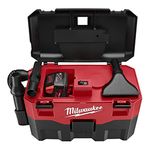Choosing a Shop Vacuum Cleaner
Air watts, cfm's, peak horsepower? When the dust settles, filter material and placement of wheels may be more important items to consider.

Synopsis: This tool survey compares the specifications, features, and performance of 12 shop vacuum cleaners that range in price from $90 to $950. The article focuses on filters, capacity, noise level, and vacuuming ability, and includes a sidebar on using a shop vacuum as a job-site dust collector.
Until an allergic reaction to redwood put me in the hospital for two weeks, I used to chase sawdust with a broom. Even though sweeping seemed to put more of the stuff in the air than it did in my dustpan, it was the best cleanup method I had. After my failed experiment with using lungs for dust collection, I went out and dropped $600 for the best shop vacuum cleaner I could find, money that I think was well spent.
The machine I bought was light and compact, so it was convenient to use on a regular basis. It was also powerful, and its filter trapped fine dust particles. I reckoned then that its high purchase price had become part of the cost of the job. My vacuum is now over five years old, and today, similar performance is available for less than half of what I paid. Although there are hundreds of so-called shop vacuums on the market, I recently looked at a dozen machines from well-known manufacturers that were advertised as being suited for contracting or carpentry work, in the shop or on the job site.
Vacuums vs. dust collectors
Shop vacuums basically consist of a motor-driven fan that draws debris-laden air in through a hose. Larger debris is collected in a canister, and the air is drawn through a filter, which is supposed to trap finer debris. The filter on a shop vacuum is between the intake port and the fan, which is what chiefly distinguishes these machines from portable dust collectors, which typically trap dust as air is exhausted.
Another difference worth noting is that dust collectors typically move larger amounts of air at slower speeds than shop vacuums. The air movement in both machines lets heavier debris (wood chips and shavings) drop to the bottom of the container before reaching the filter. This preseparation, filter location, and lower air volume make a shop vacuum ideally suited for picking up liquids because droplets of water tend to behave in the same way as heavy wood chips, falling out of the airstream and filling up the canister.
The ability to clean up spills without a mop and pail can be a great convenience (and a godsend for plumbing repairs that require dry copper). But although a shop vacuum may be perfect for sucking up your tears on April 16, its classical use still remains janitorial—cleaning up dust and debris.
For more photos and details, click the View PDF button below:
Fine Homebuilding Recommended Products
Fine Homebuilding receives a commission for items purchased through links on this site, including Amazon Associates and other affiliate advertising programs.

Homebody: A Guide to Creating Spaces You Never Want to Leave

Milwaukee Cordless Shop Vac (0880-20)

Musings of an Energy Nerd: Toward an Energy-Efficient Home






















